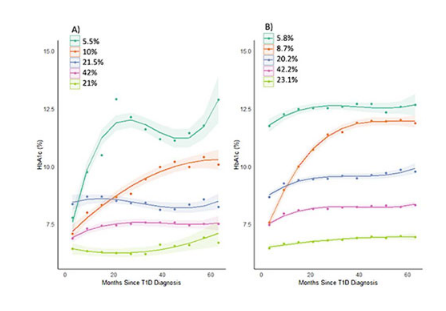Abstract: Hemoglobin A1c Trajectories Following Diagnosis of Type 1 Diabetes (T1D) in a Cohort of Children from Canada and the U.S.
Gonzalo Dominguez Menendez1, Melissa Braschel1, Kelsey Panfil2, Crystal Ng1, Brent Lockee2, Ryan Mcdonough2, Jeffrey Bone1, Mark Clements2, Shazhan Amed1
1BC Children’s Hospital, Pediatric, Canada,2Children’s Mercy, Endocrinology, United States of America
Background and Aims: Rising hemoglobin A1c (HbA1c) is linked to increased risk for diabetes-related complications inT1D. Previous research describes distinct HbA1c trajectories over time in children living with T1D. Our study aims to compareHbA1c trajectories following T1D diagnosis in a cohort of children from pediatric diabetes centers in Canada (BC Children’s Hospital, Vancouver, Canada) and the U.S. (Children’s Mercy Hospital, Kansas City, MO).
Methods: Data sources included medical record-based registries from both sites. Longitudinal data for 2,044 individuals diagnosed with T1D before the age of 18 years were included. Follow-up was for 69 months after diagnosis. HbA1c levels were aggregated as medians for each 6-month period, beginning with3-9 months after diagnosis, and requiring at least 3 semi-annual measures. Latent class analysis was employed to determine HbA1c trajectory sub-groups.
Results: The median age of diagnosis in BC-PDR and CMH were 8 and 10 years, respectively. Five latent classes with similar ATTD 2024 E-POSTER ABSTRACT PRESENTATIONSA-355 trajectories were identified in both groups (Fig 1.). These groups were low stable, intermediate stable, high stable, intermediate increasing, and high increasing. Group 5 differed most between centers, representing the smallest percentage of the sample. BCCH group 5 showed a pattern of lower HbA1c shortly after diagnosis followed by a steep rise, while HbA1c was higher shortly after diagnosis and remained higher over time in CMH group 5.

Conclusions: Five similar HbA1c trajectories following T1D diagnosis were identified in both registries. Whether use of advanced diabetes technology use changes the odds of experiencing rising HbA1c remains to be determined.